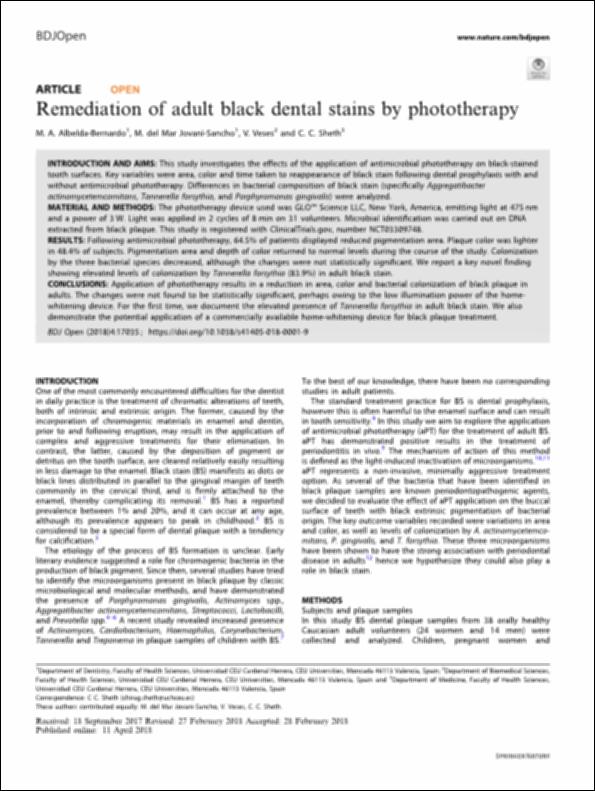Por favor, use este identificador para citar o enlazar este ítem:
http://hdl.handle.net/10637/10507Remediation of adult black dental stains by phototherapy
| Título : | Remediation of adult black dental stains by phototherapy |
| Autor : | Albelda Bernardo, María Amparo Jovani Sancho, María del Mar Veses Jiménez, Verónica. Sheth Shah, Chirag Chandrakant |
| Materias: | Mouth - Microbiology - Treatment.; Caries dental - Tratamiento.; Dental caries - Treatment.; Dental plaque - Diseases - Treatment.; Phototherapy.; Fototerapia.; Placa dental - Enfermedades - Tratamiento.; Dientes - Bacteriología - Tratamiento. |
| Editorial : | Springer Nature Switzerland AG |
| Citación : | Albelda Bernardo, MA., Jovani Sancho, MM., Veses Jiménez, V. and Sheth, CC. (2018). Remediation of adult black dental stains by phototherapy. BDJ Open, n. 4 (april), art. 17035. DOI: https://doi.org/10.1038/s41405-018-0001-9 |
| Resumen : | INTRODUCTION AND AIMS: This study investigates the effects of the application of antimicrobial phototherapy on black-stained tooth surfaces. Key variables were area, color and time taken to reappearance of black stain following dental prophylaxis with and without antimicrobial phototherapy. Differences in bacterial composition of black stain (specifically Aggregatibacter actinomycetemcomitans, Tannerella forsythia, and Porphyromonas gingivalis) were analyzed. MATERIAL AND METHODS: The phototherapy device used was GLO™ Science LLC, New York, America, emitting light at 475 nm and a power of 3W. Light was applied in 2 cycles of 8 min on 31 volunteers. Microbial identification was carried out on DNA extracted from black plaque. This study is registered with ClinicalTrials.gov, number NCT03309748. RESULTS: Following antimicrobial phototherapy, 64.5% of patients displayed reduced pigmentation area. Plaque color was lighter in 48.4% of subjects. Pigmentation area and depth of color returned to normal levels during the course of the study. Colonization by the three bacterial species decreased, although the changes were not statistically significant. We report a key novel finding showing elevated levels of colonization by Tannerella forsythia (83.9%) in adult black stain. CONCLUSIONS: Application of phototherapy results in a reduction in area, color and bacterial colonization of black plaque in adults. The changes were not found to be statistically significant, perhaps owing to the low illumination power of the homewhitening device. For the first time, we document the elevated presence of Tannerella forsythia in adult black stain. We also demonstrate the potential application of a commercially available home-whitening device for black plaque treatment. |
| Descripción : | Este artículo se encuentra disponible en la página web de la revista en la siguiente URL: https://www.nature.com/articles/s41405-018-0001-9 |
| URI : | http://hdl.handle.net/10637/10507 |
| Derechos: | http://creativecommons.org/licenses/by/4.0/deed.es |
| ISSN : | 2056-807X (Electrónico) |
| Fecha de publicación : | 11-abr-2018 |
| Centro : | Universidad Cardenal Herrera-CEU |
| Aparece en las colecciones: | Dpto. Odontología |
Los ítems de DSpace están protegidos por copyright, con todos los derechos reservados, a menos que se indique lo contrario.


